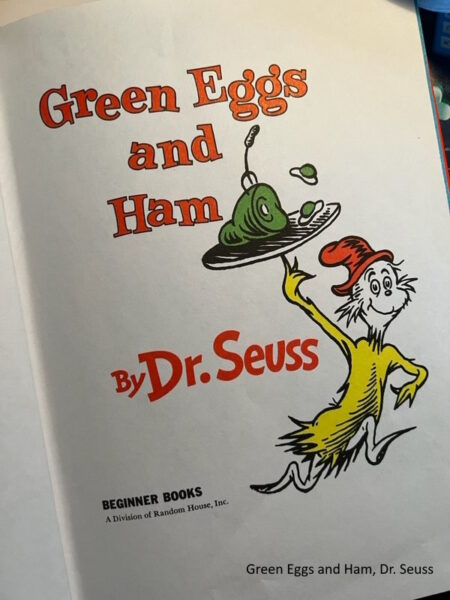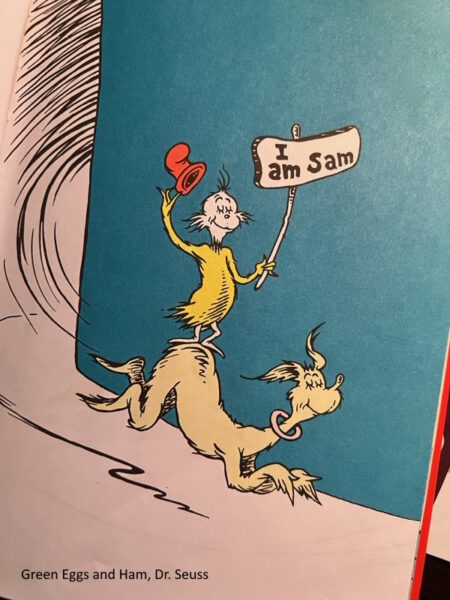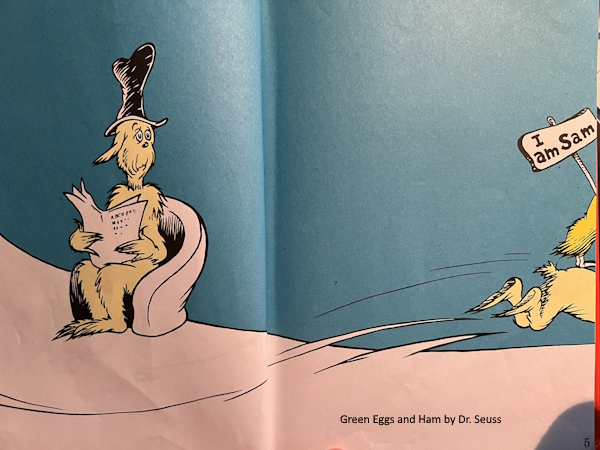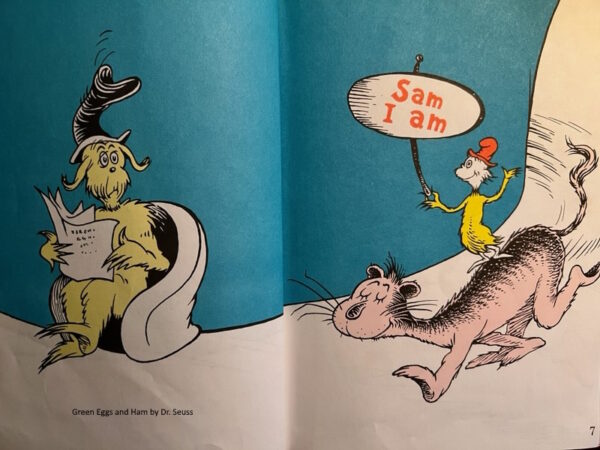My children enjoyed reading the story Green Eggs and Ham. This picture book is referenced in movies, sitcoms, jokes, and general conversations because of its classic story line. Many can quote sections of this book, including the little rhyme:
I do not like green eggs and ham.
I do not like them, Sam-I-am.
Prior to our 11-year stint in speech therapy, I would have read this story to my children from cover to cover. Then we would have moved to the next book in the pile. But Bubs’ therapy taught me that a quality children’s book is so much more than words to be read from page to page.

Pragmatics and Facial Expression
For today’s post we will be focusing on the engaging illustrations that draw in the child and teach pragmatics and facial expression. Pragmatics is the study of language in a social setting. Think communication. Just as children struggle with emotions, many children struggle with expressing themselves and understanding the unspoken language given to them in conversations. While some children learn by example, others must be taught this hidden curriculum of facial expressions and emotions. This is especially true of children who fall under the Autism umbrella, those with Sensory Processing Disorder, and kiddos who have Traumatic Brain Injury.
For a personal example, not understanding social language is why Bubs didn’t understand the “mommy look.” He couldn’t read my face and understand how I am feeling. He also didn’t understand what babies were telling him and got confused in social conversations at school.
Using the story of Green Eggs and Ham, I’m so excited to share what I have learned about unlocking the hidden power of a children’s book, as I wish someone would have taught me the simple tips when my kiddos were young.

Pragmatic Learning from the Book’s Cover
Who knew learning could happen just from looking at the cover of the book? Begin by analyzing the cover and title page by reading the title as well as the name of the author and illustrator. Here are some possible questions to begin discussion:
- What does the title tell you about the book?
- Based on the title what do you think will happen in this book?
- What is this character doing? Why?
- The character’s eyebrows are raised. How is he feeling? What is he thinking?
Remind the child that as long as his/her answers are relevant, there are no wrong answers during the brainstorm session.

The Character’s Eyes, Mouth, and Hands
Turning to the first page of the story, we see Sam standing on the back of a yellow dog…something. We will call it an animal. He is holding a sign saying “I am Sam.” What is Dr. Seuss telling us in this illustration?
Explain to the child that the curved lines show motion – the animal and Sam came from around the corner – and probably came pretty quickly according to the number of curved lines. Sam is standing on the animal. Why would he do this?
To answer these questions, we need to look at the facial expression of each character. Teach the child to look at the character’s eyes, eyebrows, mouth, and hands. After sharing, always ask the child “why” to support their answer. This teaches the child to look at the illustration and use pragmatics to develop an answer.
How is Sam feeling and why?
- happy – smile on his face, his lips are curved upward
- smug – eyes are closed and eyebrows are up
- introducing himself – eyes are closed, has a sign, holding his hat up
Remember that during this brainstorming session you are strictly going off the illustrations of the story. As you and the child move through the pages, you may change your opinions. And that is okay. The point is to begin looking deep into the illustrations and developing an understanding of the unspoken social language.

No More “I Don’t Know” Answers
Let’s meet a new character on the following page. “From looking at his face and what he is doing, how does he feel?” It will take some training to move the child away from the “I don’t know answer,” but it is so worth it! Begin by modeling what you see to give words for the child to use.
- stunned, surprised – eyes large, eye brows up
- looking at a newspaper, sitting in a chair – relaxing, probably not expecting an animal and Sam to go rushing by
- only half of the animal is showing – quickly moving, Sam didn’t acknowledge the new character

And We Are Only Getting Started Teaching Pragmatics!
On the following page the characters introduce some new facial expressions of fright and bewilderment.
- The animal is different looking – looks and color
- Sam has a new sign and is waving – waving is saying hi
- The left page characters’ hat shows movement – Does this mean he whipped his head around quickly?
- With one foot off the ground the character is showing he may be afraid it will get run over.
Only five pages in and be amazed at all the pragmatic learning that has just taken place! No longer is the book a bunch of words and pictures. Suddenly the child begins to connect emotionally with the characters and understand their point of view. This is learning that all children need to be exposed to.
I want to invite you to learn more about this pragmatic process that we call picture walking. I have created several free videos for you to learn more. Also, check out reels and shorts on YouTube, Pinterest, and Instagram and join us for conversation on the ABCJesusLovesMe page on Facebook to learn more.
